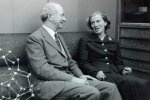
When Clara first arrived in Hodgkin's laboratory she worked for two months with David Sayre on direct methods for determining structure without the use of Patterson maps. Then Hodgkin started her working on vitamin B12 crystals. Clara still remembers Hodgkin's skill at mounting crystals in spite of her arthritic hands. This was a new technique for Clara and she was very successful in obtaining three-dimensional intensity data for the hydrated B12. The unit cell dimensions were determined from these data and were shown to be considerably larger than the unit-cell dimensions of the less-hydrated, "air-dried" B12 crystals.
Clara stayed through the end of the 1951 calendar year and Hodgkin obtained money to pay her for a few months after she had expended her fellowship funds. The work that she did during this one visit to Hodgkin's laboratory resulted in three important publications with Hodgkin on B12 (Nature, 1954; Proc. Royal Soc. A., 1964.)
According to Clara, Hodgkin's policy of putting the names of the authors of papers in alphabetical order, resulted in the embarrassing fact that Clara's name came first on the paper in Nature. Clara also recalls that Hodgkin sent her articles to review before publication and was especially generous with co-authors on major publications.
During this time Clara remembers being invited by Hodgkin to her home several times, and when Van Arkel came to visit her they both were invited to the Hodgkin home. Clara has fond memories of working with Hodgkin during the 1950-51 time period, and she maintained contact and a personal relationship with her until Hodgkin died in 1994. Clara maintains contact with June Broomhead Lindsey who was working on dry B12 with Hodgkin when Clara was there. Broomhead lives in Canada, but she gave up her crystallographic career soon after she married.
The X-ray crystallography group at Oxford, when Clara was there in 1951, was divided into two parts. Hodgkin directed the group of students and scientists working on organic structures, while H.M. "Tiny" Powell directed the group working on inorganic structures. Somerville College students would have naturally been part of the Hodgkin Group. They all worked in the same room and shared the same instruments. The relationship between the two groups appeared to be seamless and when either Hodgkin or Powell was unavailable or away on travel, the other one took care of both groups.
In spite of the arthritis that visibly crippled her hands, Hodgkin never complained of pain or the limitations of her affliction. Clara describes Hodgkin as always having a serenity about her. Clara does, however, recall one occasion where Hodgkin became exasperated with a young man who could not seem to figure out the structure he was working on, leading Hodgkin to take it home with her in the evening and bring it back in the morning with the solution. It was not unusual for Hodgkin to take work home in spite of her family responsibilities.
Clara recalled that Hodgkin had a sister who, with her two children, lived with Hodgkin in the late fifties, helping out with the running of the household, which then consisted of three adults and five children. Hodgkin's husband was well-known for his Italian desserts that contained lots of eggs and Marsala wine -- a variation of zabaglione -- that he loved to whip up for guests.
When Clara returned to Leiden, after her stimulating experience in Oxford, she found things the same as before, and she again became unhappy with her situation. According to her own account she did not get along with some of the people at Leiden, particularly another woman in the department who did not support her. Even though she felt supported by van Arkel, he did not seem to have enough clout to smooth the way for her.
This time Caroline MacGillavry recommended that she take a leave of absence and go to the United States for further study. Dorothy Hodgkin and Caroline MacGillavry both wrote letters of recommendation for Clara to Linus Pauling at Caltech and David Shoemaker at MIT. Eddie Hughes at Caltech suggested to MacGillavry that Clara might benefit by working with David Shoemaker on metals, as that was a new area for her. Clara showed me copies of the recommendation letter from Hodgkin to Shoemaker that she found in her husband's files after he died. The letter from Dorothy was handwritten in very straight lines of tiny printed script with lots of white space between the lines, giving the overall impression of a delicate pattern rather than a written page of text.


